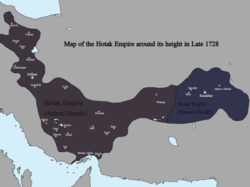
Back الدولة الهوتكية Arabic عيلة هوتاكى ARZ Dinastía Hotaki AST Hotakilər Azerbaijani هوتاکی دؤولتی AZB Хатакі Byelorussian হুতাক রাজবংশ Bengali/Bangla Hotaki-Dynastie German Δυναστεία Χοτάκ Greek Hotaka dinastio Esperanto
Hotak dynasty | |||||||||||
|---|---|---|---|---|---|---|---|---|---|---|---|
| 1709–1738 | |||||||||||
 Hotak dynasty at its greatest extent | |||||||||||
| Capital | Kandahar (1709–1722), (1725–1738) Isfahan (1722–1729) | ||||||||||
| Common languages | Pashto (poetry)[1] Persian (poetry)[a][1] | ||||||||||
| Religion | Sunni Islam | ||||||||||
| Government | Absolute monarchy | ||||||||||
| Emir | |||||||||||
• 1709–1715 | Mirwais Hotak | ||||||||||
• 1715–1717 | Abdul Aziz Hotak | ||||||||||
• 1717–1725 | Mahmud Hotak | ||||||||||
• 1725–1730 | Ashraf Hotak | ||||||||||
• 1725–1738 | Hussain Hotak | ||||||||||
| Historical era | Early modern period | ||||||||||
• Revolt by Mirwais Hotak | 21 April 1709 | ||||||||||
| 24 March 1738 | |||||||||||
| |||||||||||
The Hotak dynasty (Pashto: د هوتکيانو ټولواکمني Persian: امپراتوری هوتکیان) was an Afghan monarchy founded by Ghilji Pashtuns that briefly ruled portions of Iran and Afghanistan during the 1720s.[2][3] It was established in April 1709 by Mirwais Hotak, who led a successful rebellion against the declining Persian Safavid empire in the region of Loy Kandahar ("Greater Kandahar") in what is now southern Afghanistan.[2]
In 1715, Mirwais died of natural causes and his brother Abdul Aziz succeeded him. He did not reign long as he was killed by his nephew Mahmud, who deposed the Safavid Shah and proclaimed his own rule over Iran. Mahmud in turn was succeeded by his cousin Ashraf following a palace coup in 1725. Ashraf also did not retain his throne for long, as the Iranian conqueror Nader-Qoli Beg (later Shah), leading the resurgent Safavid banner, defeated him at the Battle of Damghan of 1729. Ashraf Hotak was banished to what is now southern Afghanistan, confining Hotak rule to a small corner of their former empire. In 1738, Hotak rule ended when Nader Shah defeated Ashraf's successor Hussain Hotak after a lengthy siege of Kandahar. Subsequently, Nader Shah began re-establishing Iranian suzerainty over regions lost decades before to Iran's archrivals—the Ottoman and Russian Empires.[4]
- ^ a b c Bausani 1971, p. 63.
- ^ a b Malleson, George Bruce (1878). History of Afghanistan, from the Earliest Period to the Outbreak of the War of 188. London: Elibron.com. p. 227. ISBN 1402172788. Archived from the original on 2023-03-10. Retrieved 2010-09-27.
- ^ Ewans, Martin (2002). Afghanistan: a short history of its people and politics. New York: Perennial. p. 30. ISBN 0060505087. Archived from the original on 2023-03-10. Retrieved 2010-09-27.
- ^ "AN OUTLINE OF THE HISTORY OF PERSIA DURING THE LAST TWO CENTURIES (A.D. 1722-1922)". Edward Granville Browne. London: Packard Humanities Institute. p. 33. Archived from the original on 2016-03-04. Retrieved 2010-09-24.
Cite error: There are <ref group=lower-alpha> tags or {{efn}} templates on this page, but the references will not show without a {{reflist|group=lower-alpha}} template or {{notelist}} template (see the help page).